Here's how my mornings often go lately: wake up, turn off alarm, lounge in bed checking email and trying to decide what to do with the day, fix on some interesting or quirky London-y thing, roll out of bed and get on with it. Don't hate me. If the number of hours I worked last summer were distributed across a normal 40-hour week I'd still be employed, so you can just shut up. And of course I'm spending good chunks of time trying to find work, but there's only so much of that I can do before I get so discouraged I start considering a change in career. (Those living statues at Covent Garden seem to do ok, and I've always said I wanted to work in the West End...)
Last week I had a vague notion that I should go check out the Natural History Museum, which is the only one of the Big Three museums located in South Kensington that I haven't ever visited. (The other two are the Science Museum and the Victoria & Albert Museum of Art and Design, making for a particularly richly-endowed few blocks of London, which is already no slouch in the Interesting Things Per Square Block category.) So as I lounged in bed I opened up the NHM museum website and had a poke around to make sure that 1) it was open and 2) it was free. The museum scored on both points, thus warranting further investigation to find out what, if any, guided tours were offered that day. If you've read any of my previous blog (Go See Run Eat Drink) you know that I'm a huge fan of a good guided tour, especially for large and somewhat daunting sites and most especially if the tour is free. Again, the Natural History Museum scored a hit, offering something called the Spirit Collection Tour (and not just the regular one but the once-a-week extended tour). I have to admit that I had no notion what a spirit collection might be comprised of, and envisioned shamanistic what-nots mostly consisting of feathers and bones and beads and carved fertility figurines and such. Not exactly in my line, but I like to fancy myself a bit of a polymath and it never hurts to expand one's knowledge a bit. The 3:00 pm tour suited me down to the ground, so off I went.
The collections of the Natural History Museum are based on the purchase, in the mid-eighteenth century, of the miscellany of Sir Hans Sloane (he of Sloane Square, Street, and Gardens; Hans Street, Crescent, Place and Road; the Urania sloanus moth, the plant genus Sloanea and "Sloane Rangers"). Sloane was a physician and keen collector of curiosities and natural specimens. Later in life he became a sort of meta-collector, acquiring quite a few other people's collections, which meant that at the time of his death he had rather a lot of interesting things in his back cupboard.
"On his death on 11 January 1753 he bequeathed his books, manuscripts, prints, drawings, flora, fauna, medals, coins, seals, cameos and other curiosities to the nation, on condition that parliament should pay to his executors £20,000, which was a good deal less than the value of the collection." (Wikipedia)
Sloane's collection was the start of the British Museum, and the natural history specimens were later separated and became the foundation of the Natural History Museum. (Interesting Aside Number One: Sloane is also responsible for the introduction of drinking chocolate to England and devised the milk-and-chocolate version, as opposed to the water-and-chocolate version popular in Jamaica, where Sloane first encountered it. Frankly, we have a lot to thank him for. Sadly, the café at the Natural History Museum does not take full advantage of this fact.)
The Natural History Museum building, it turns out, is amazingly fantastic. Built in high Victorian style and opened in 1881, it's sometimes referred to as a cathedral of nature, and I can understand why. The entrance hall really took my breath away.
It's like Hogwarts, with dinosaurs!
In my opinion this is what all museums should be like. Yes, we can have modern additions and whizz-bang technology and interactive crap and whatever. But in the middle, can we please have a bloody big, gorgeous room with proper arches and vaults and columns and mezzanines and something enormous stuffed or mounted right in the middle? Thank you.
Also eminently acceptable: Kelvingrove Museum, Glasgow
Another excellent feature of the architecture of the Natural History Museum.
The Natural History Museum is most famous for its collection of dinosaur skeletons (the one in the main hall is called "Dippy" and is a cast of a diplodocus skeleton that was a gift of Andrew Carnegie and is based on the original skeleton at the Carnegie Museum). There are also extensive galleries on mammals, including a complete blue whale skeleton, and a whole gallery on geology, fossils and rocks, and stuff on human evolution and, well, lots. I got there a bit early so I wandered around a bit, ambling in and out of various collections in the luxuriously unhurried manner of one who knows she can return at any time at no cost, which is a truly lovely feeling.
At 3:00 I presented myself in the Darwin Centre wing of the building for the Spirit Collection Tour (which though free, requires that you reserve a ticket at the reception desk in the Hogwarts room - potential visitors take note). There were only six of us in the group, and our guide was Alistair, a curator in the Spirit Collection. And that's when I discovered exactly what a Spirit Collection is, and let me tell you it is WAY cooler than some old rattles and feathers and crap. The Natural History Museum Spirit Collection consists of more than twenty two million animal specimens floating in glass jars, preserved in alcohol spirits. It's not a collection about spirits. It's a collection in spirits.
Alistair was an excellent guide, and being in a small group meant that we got to go behind the scenes deep into the working part of the museum. The Natural History Museum is a world class research facility and the spirit collection gets used by visiting scholars from all over the world. I was surprised to learn that the jars are regularly opened and their contents tipped out to be prodded, dissected and studied, before being plopped back into the jars, topped up with a fresh batch of alcohol, and tucked back onto the shelves. Monitoring and refreshing the fluid level in the jars is one of Alistair's jobs and is made slightly less onerous by the practice of keeping the storage areas a chilly 16 degrees (the alcohol evaporates more quickly in high temperatures). They also seal the tops with a layer of vaseline, which seemed a bit ordinary, but then I suppose that's the same reaction people would have if they found out exactly how much of the Opening Ceremony was held together with duct tape and cable ties.
I was also surprised that they use alcohol to preserve most specimens, not formaldehyde. This is partly because formaldehyde is nasty and toxic and very very smelly, and partly because it destroys the DNA of the sample. It's now used mostly for large samples where alcohol doesn't work as well and where DNA samples can be taken before preservation.
Alistair opened a few random cabinets in his favourite section (Mollusca) and showed us some cock-eyed squid and other bits and bobs. Some of the jars had red paint on the lids, which indicated that they were the "type specimen" for that species. A type specimen is the (usually) single example of a species on which the description and classification of the species are based, and the Natural History Museum has a lot of them - another indication of the prestigiousness of the collection. We also saw several yellow-painted lids, which Alistair revealed to be type specimens of fish. Why weren't they red as well? "That's just the Fish People being awkward", said Alistair. Who knew there was such controversy about type specimen labelling?
As interesting as it was to poke around in the endless shelves of smaller samples the undoubted highlight of the tour was a visit to the tank room. The tank room is where all the really big jars are kept. While the rest of the collection is rigorously organised according to phylum and class and such, the tank room is a higgeldy-piggeldy collection of large jars and even larger tanks holding everything from coelacanths to sharks to monkeys. The really big tanks, sadly, are steel reinforced and require chains and cranes and things to get them open, so no peeking at the pickled ponies for me. (Yes, apparently there is a pony.)
The star of the tank room, in fact the star of the whole spirit collection, is certainly Archie. "Archie" is the rather undignified name given to the giant squid sample whose latin name is Architeuthis dux, hence the pithy diminutive. Measuring 8.62 metres long, the squid is housed in a 9 metre long custom-made tank. Giant squid live in very deep water and hence specimens are extremely rare. Archie was caught, alive, in a fishing net near the Falkland Islands in 2004. Up to that point most specimens were only partially complete, having been recovered from the stomachs of sperm whales.
(Interesting Aside Number Two: Giant squid themselves are not hugely rare, they're just hard to find. Estimates of the population are based on the frequency at which beaks from the giant squid and the even bigger colossal squid, along with the beaks of many many other much smaller squid species, show up in the stomach contents of sperm whales. The beaks are highly indigestible so they accumulate in the stomach, sometimes in the thousands. As a reaction to the beaks - they're hard and kind of irritating, as you can well imagine - the whale's stomach produces a thick, black, foul-smelling goo called... anyone? Yep. Ambergris. And where else on the internet will you get to read a blog post that goes from living statues to hot chocolate to ambergris with seamless elegance?)
Nothing could top the Tank Room (barring the sudden resurrection of Dippy, or an all-out type specimen labelling war between the Fish People and Everyone Else, with much flinging of red and yellow paint bombs) so the tour wound up and we took the glass elevator back up to the public area. By that time it was fully dark. The sun sets a full half an hour earlier here than it does in Winnipeg, and an hour earlier than Saskatoon, which does my head in. It's hard enough to get motivated to do anything when you're not working, but having it dark by four o'clock puts hibernation mode into overdrive, regardless of whether the temperature is particularly cold (which it isn't). Luckily, the museum building is just as pretty from the outside as it is from the inside, and I had a nice hash run to look forward to that evening, so I toddled off to the tube station feeling pretty content with my lot. Yes, I'm unemployed and living off a dwindling savings account, but I'm unemployed in London, which is not such a bad thing.
I was also surprised that they use alcohol to preserve most specimens, not formaldehyde. This is partly because formaldehyde is nasty and toxic and very very smelly, and partly because it destroys the DNA of the sample. It's now used mostly for large samples where alcohol doesn't work as well and where DNA samples can be taken before preservation.
Alistair opened a few random cabinets in his favourite section (Mollusca) and showed us some cock-eyed squid and other bits and bobs. Some of the jars had red paint on the lids, which indicated that they were the "type specimen" for that species. A type specimen is the (usually) single example of a species on which the description and classification of the species are based, and the Natural History Museum has a lot of them - another indication of the prestigiousness of the collection. We also saw several yellow-painted lids, which Alistair revealed to be type specimens of fish. Why weren't they red as well? "That's just the Fish People being awkward", said Alistair. Who knew there was such controversy about type specimen labelling?
There are 27 kilometres of shelving, which makes the whole place seem a bit like the
Department of Mysteries, but with better lighting.
The tank room.
The star of the tank room, in fact the star of the whole spirit collection, is certainly Archie. "Archie" is the rather undignified name given to the giant squid sample whose latin name is Architeuthis dux, hence the pithy diminutive. Measuring 8.62 metres long, the squid is housed in a 9 metre long custom-made tank. Giant squid live in very deep water and hence specimens are extremely rare. Archie was caught, alive, in a fishing net near the Falkland Islands in 2004. Up to that point most specimens were only partially complete, having been recovered from the stomachs of sperm whales.
(Interesting Aside Number Two: Giant squid themselves are not hugely rare, they're just hard to find. Estimates of the population are based on the frequency at which beaks from the giant squid and the even bigger colossal squid, along with the beaks of many many other much smaller squid species, show up in the stomach contents of sperm whales. The beaks are highly indigestible so they accumulate in the stomach, sometimes in the thousands. As a reaction to the beaks - they're hard and kind of irritating, as you can well imagine - the whale's stomach produces a thick, black, foul-smelling goo called... anyone? Yep. Ambergris. And where else on the internet will you get to read a blog post that goes from living statues to hot chocolate to ambergris with seamless elegance?)
Archie in his (actually, they think Archie is a "her") tank. The preserving process is really not kind to the natural colours of, well, anything. Most specimens get reduced to a common and somewhat disturbing pale yellowy grey. (There's a Youtube video here that shows the natural colours of the quid before it was turned into formalin soup.)
Nothing could top the Tank Room (barring the sudden resurrection of Dippy, or an all-out type specimen labelling war between the Fish People and Everyone Else, with much flinging of red and yellow paint bombs) so the tour wound up and we took the glass elevator back up to the public area. By that time it was fully dark. The sun sets a full half an hour earlier here than it does in Winnipeg, and an hour earlier than Saskatoon, which does my head in. It's hard enough to get motivated to do anything when you're not working, but having it dark by four o'clock puts hibernation mode into overdrive, regardless of whether the temperature is particularly cold (which it isn't). Luckily, the museum building is just as pretty from the outside as it is from the inside, and I had a nice hash run to look forward to that evening, so I toddled off to the tube station feeling pretty content with my lot. Yes, I'm unemployed and living off a dwindling savings account, but I'm unemployed in London, which is not such a bad thing.
The Natural History Museum, in the moody darkness

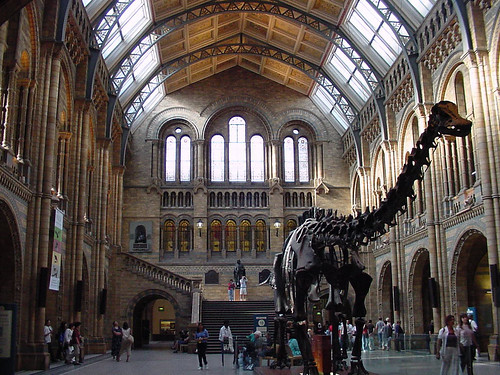

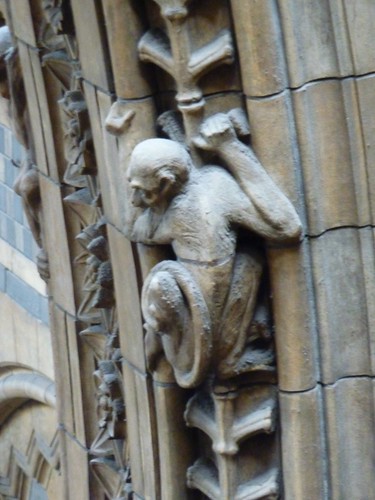
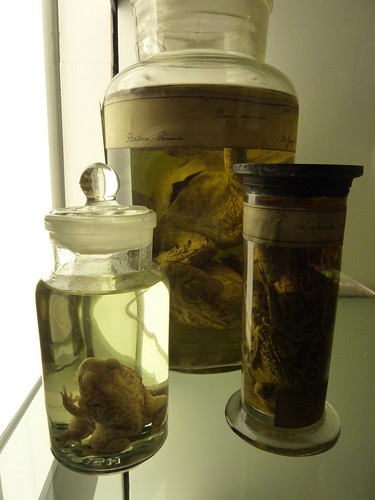

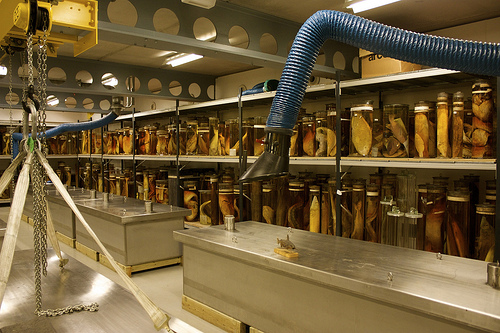
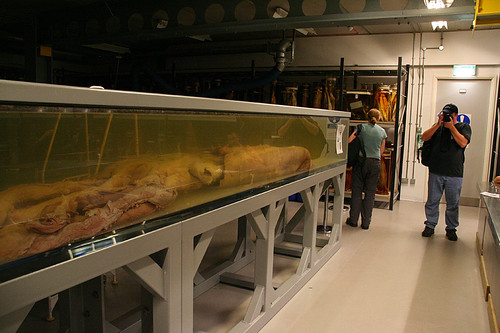
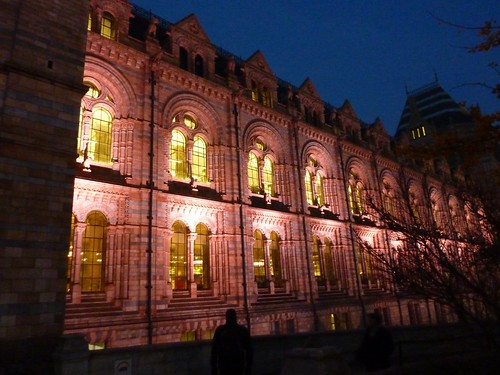


0 Comments:
Post a Comment